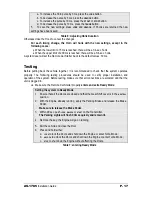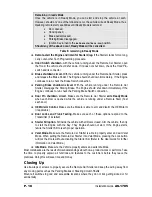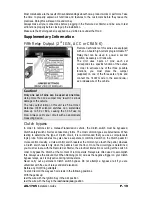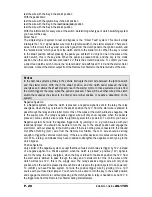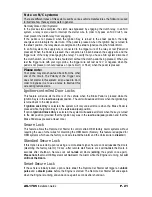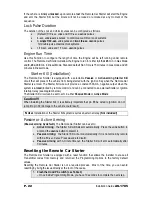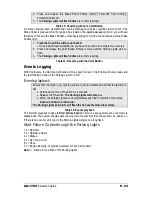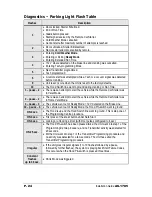
P. 20
Installation
Guide
AS-1785
test the wire with the Key in the
START
position
With the pedal down:
test the wire with the Ignition Key in the
OFF
position
test the wire with the Key in the
IGNITION ON (RUN)
position
test the wire with the Key in the
START
position
With this information for every wire at the switch, determining what type of clutch switching system
you have will be easy.
Direct Feed:
The simplest type of system to test and bypass is the “Direct Feed” system. This circuit simply
interrupts the +12 V signal starter wire from the Ignition switch to the starter solenoid. There are 2
wires in this circuit, the “key side” wire which goes from the clutch pedal to the Ignition switch, and
the “solenoid side” which goes from the clutch switch to the starter motor. When the key is turned
to the
START
position without pressing the pedal, you will test 12 V only on one of the wires at the
clutch switch, this is the key side. When the pedal is pressed down, and the key is the crank
position, the other wire will now also read 12 V, this is the solenoid side wire. To confirm you have
a direct feed clutch switch, hot wire the “solenoid side” wire with fused +12 V, and the starter motor
will crank. Connect the starter output from the Remote Car Starter to the Solenoid side of the wire.
Note:
In the next two systems a Relay in the vehicle interrupts the start wire between the Ignition switch
and the starter motor. With the in the
START
position, and the clutch pedal pressed, the relay
energizes and allows the
START
signal to reach the starter motor. In these systems a wires from
the clutch triggers the relay, when the pedal is pressed. There will be another wire at the clutch
switch that supplies the signal to the trigger wire (either positive or negative, depending on the
system)
Negative Systems:
In a Negative system, when the clutch is pressed; a negative signal is sent to the relay, the relay
energizes, when the Key is turned to the
START
position the 12 V from the start wire is allowed to
pass through the relay and to starter motor. One of the wires at the clutch will test as negative, this
is the supply wire. The relay's negative trigger wire will only show negative when the pedal is
pressed ( some vehicle's also require the Ignition system to be powered). To confirm you have a
Negative system, hot wire the negative trigger wire by jumping it to a ground source with your
fused test jumper. You should now be able to turn the key to the
START
position and engage the
start motor, with out pressing in the clutch pedal. If there is nothing else connected to the Ground
Out When Running (G.O.) wire from the Remote Car Starter, the G.O. wire should be strong
enough to trigger the vehicle's clutch relay . If there are other devices or modules connected to the
G.O. Wire, a relay ( and diodes) may have to added to strengthen the negative current going to the
clutch bypass.
Positive Systems:
Very similar to the negative system, except that the vehicle's clutch relay is trigger by 12 V, instead
of a negative signal. In a Positive system, when the clutch is pressed; a positive (12 V) signal is
sent to the relay, the relay energizes, when the Key is turned to the
START
position the 12 V from
the start wire is allowed to pass through the relay and to starter motor. One of the wires at the
clutch will test as 12 V, this is the supply wire. The relay's positive trigger wire will only show
positive when the pedal is pressed (some vehicle's also require the Ignition system to be powered).
To confirm you have Positive system, hot wire the positive trigger wire by jumping it to a 12 V
source with your fused test jumper. You should now be able to turn the key to the
START
position
and engage the start motor, without pressing in the clutch pedal. A relay is needed to send 12 V to
the trigger wire from the Remote Car Starter during start attempts.












